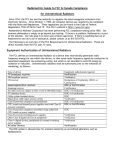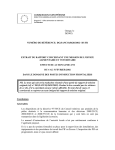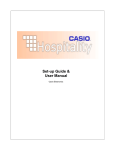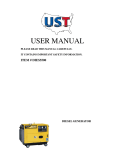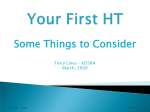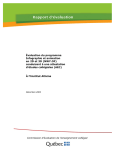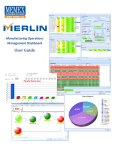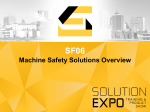Download FCC Quick Guide - EMC Testing at dB Technology
Transcript
Issue No: 4 Date: 10/07/07 Page: Quick Guide - EMC in the USA 1 of 7 EMC and the USA A Quick Guide dB Technology (Cambridge) Ltd. Registered in England, No: 3452992 VAT Registration No: 700 2219 02 Issue No: 4 Date: 10/07/07 Page: Quick Guide - EMC in the USA 2 of 7 Authorities The Federal Communication Commission1 (FCC) is the authority responsible for overseeing the authorisation of equipment using the radio frequency (RF) spectrum in the USA (this covers both intentional and unintentional transmitters). The Office of Engineering & Technology2 is responsible for advising the commission on such matters. Rules & regulations The FCC rules and regulations are laid out in Title 47 of the Code of Federal Regulations (CFR47)3. This title consists of many parts, only a few of which are applicable to electronic equipment. The parts listed below are those to which we commonly test. Devices may not be imported and/or marketed until they have shown compliance with the technical standards which have been specified by the Commission. Part 2 - Frequency Allocations and Radio Treaty Matters; General Rules and Regulations Part 15 - Radio Frequency Devices Part 18 - Industrial, Scientific and Medical Devices dB Technology (Cambridge) Ltd. Registered in England, No: 3452992 VAT Registration No: 700 2219 02 Issue No: 4 Date: 10/07/07 Page: Quick Guide - EMC in the USA 3 of 7 Example Routes of compliance CFR47 Part 18 (ISM Devices) Consumer products Non consumer products Part 15 Certification (2.907) (Radio Frequency Devices) Verification (2.902) Declaration of conformity (2.906) SubPart C SubPart B (Intentional radiators) (Unintentional radiators) (15.101) TV broadcast receivers FM broadcast receivers Stand-alone cable input selector switch Class B external switching power supplies Other Class B digital devices & peripherals Class A digital devices, peripherals & external switching power supplies All other devices (15.101) (15.101) CB receiver Superregenerative receiver All other receivers subject to Part 15 TV interface device Class B personal computers & peripherals CPU boards and internal power supplies used with Class B personal computers Cable system terminal device Class B personal computers assembled using authorised CPU boards or power supplies (15.101) Scanning receiver Radar detector Access Broadband over Power Line (Access BPL) Verification (2.902) dB Technology (Cambridge) Ltd. Declaration of conformity (2.906) Registered in England, No: 3452992 Certification (2.907) VAT Registration No: 700 2219 02 Issue No: 4 Date: 10/07/07 Page: Quick Guide - EMC in the USA 4 of 7 Routes of compliance explained3/4 Verification (2.902) The manufacturer is able to make measurements or take the necessary steps to ensure the product complies with the appropriate technical standards. There is no requirement to submit a sample unit or data to the Commission to demonstrate compliance. The manufacturer can therefore test the product themselves or test at a facility of their choice. Details of such testing should be kept on file and only need be produced if requested. A full description of the test facilities must also be kept unless tests are performed at a site whose details are filed with the FCC (e.g. dB Technology). Certification (2.907) This is an authorisation procedure whereby the Commission or, more commonly, a Telecommunications Certification Body (TCB) issues an authorisation following the submission of test data by the applicant. For certification, measurements must be made at one of the following: a site whose facilities are filed with the FCC (e.g. dB Technology) a site accredited under NVLAP (see below) Declaration of conformity (2.906) This is a process whereby a responsible party makes measurements or takes the necessary steps to ensure the product complies with the appropriate technical standards. There is no requirement to submit a sample unit or data to the Commission to demonstrate compliance unless specifically requested. A responsible party is a test house that has been accredited by the National Voluntary Laboratory Accreditation Program (NVLAP) or one that has been designated by the Commission under a Mutual Recognition Agreement (MRA). Can dB Technology complete my testing? dB Technology has its test site description filed with the FCC (Reg: 90528) but is not accredited by NVLAP. This means that we have submitted the information required by Part 2.948 of the FCC Rules for measuring devices subject to Certification under Parts 15 & 18. We are therefore only able to operate the Verification and Certification requirements. For Certification the manufacturer will also need to invlove a TCB. dB Technology will provide the test data required for vetting by the TCB, but all other parts of the application will need to be handled by the manufacturer. A search of sites that either have details of test facilities filed with the FCC under the requirements of Part 2.948 or are accredited for FCC testing by NVLAP can be found at: https://gullfoss2.fcc.gov/oetcf/eas/reports/TestFirmSearch.cfm dB Technology (Cambridge) Ltd. Registered in England, No: 3452992 VAT Registration No: 700 2219 02 Issue No: 4 Date: 10/07/07 Page: Quick Guide - EMC in the USA 5 of 7 Flowchart for Part 15 SubPart B Verification The majority of our customers will follow the verification route to FCC compliance. The following flowchart acts as a quick guide to ensure the correct process had been followed. Part numbers referenced from CFR473. Test Test to the appropriate technical standards and retain test data. Retain full description of test site facilities according to Part 2.948 of the FCC Rules unless the test site's details are already filed with the FCC. Label DO NOT ATTACH THE FCC LOGO FOR VERIFICATION PRODUCTS - PRODUCT MUST BE UNIQUELY IDENTIFIED 15.19 (a)(3) All other devices shall bear the following statement in a conspicuous location on the device: This device complies with part 15 of the FCC Rules. Operation is subject to the following two conditions: (1) This device may not cause harmful interference, and (2) this device must accept any interference, including interference that may cause undesired operation. Information to the user 15.21 The users manual or instruction manual for an intentional or unintentional radiator shall caution the user that changes or modifications not expressly approved by the party responsible for compliance could void the user's authority to operate the equipment. In cases where the manual is provided only in a form other than paper, such as on a computer disk or over the Internet, the informationrequired by this section may be included in the manual in that alternative form, provided the user can reasonably be expected tohave the capability to access informatio nin that form. 15.105(a) Class A device For a Class A digital device or peripheral, the instructions furnished the user shall include the following or similar statement, placed in a prominent location in the text of the manual: Note: This equipment has been tested and found to comply with the limits for a Class A digital device, pursuant to part 15 of the FCC Rules. These limits are designed to provide reasonable protection against harmful interference when the equipment is operated in a commercial environment. This equipment generates, uses, and can radiate radio frequency energy and, if not installed and used in accordance with the instruction manual, may cause harmful interference to radio communications. Operation if this equipment in a residential area is likely to cause harmful interference in whic case the user will be required to correct the interference at his own expense. Class B device 15.105(b) For a Class B digital device or peripheral, the instructions furnished the user shall include the following or similar statement, placed in a prominent location in the text of the manual: Note: This equipment has been tested and found to comply with the limits for a Class B digital device, pursuant to part 15 of the FCC Rules. These limits are designed to provide reasonable protection against harmful interference in a residential installation. This equipment generates, uses and can radiate radio frequency energy and, if not installed and used in accordance with the instructions, may cause harmful interference to radio communications. However, there is no guarantee that interference will not occur in a particular installation. If this equipment does cause harnful interference to radio or television reception, which can be determined by turning the equipment off and on, the user is encourgaed to try to correct the interference by one or more of the following measures: -Reorient or relocate the receiving antenna -Increase the separation between the equipment and receiver -Connect the equipment into an outlet on a circuit different from that to which the receiver is connected -Consult the dealer or an experienced radio/TV technician for help dB Technology (Cambridge) Ltd. Registered in England, No: 3452992 VAT Registration No: 700 2219 02 Issue No: 4 Date: 10/07/07 Page: Quick Guide - EMC in the USA 6 of 7 How does testing to the FCC regulations differ to Europe for unintentional radiators? When considering unintentional radiators there is really very little additional testing required if a manufacturer is already submitting a unit for testing to the European requirements. The USA has no requirements for immunity tests only emission tests. Although these tests will be carried out in order to meet European requirements it is necessary to repeat these tests with the unit powered from US mains voltage. The radiated emissions may also need to be tested above 1GHz depending on the maximum operating clock frequency of the unit under test. Tests required Europe USA Emission tests Immunity tests Radiated emissions 30MHz-1GHz Conducted emissions (UK mains voltage) Various other emission tests Radiated emissions 30MHz - 1GHz (or more) Conducted emissions (US mains voltage) No other emission tests Radiated immunity Conducted immunity Various other immunity tests No requirements How do I determine whether I need to test my unintentional radiator to Class A or Class B limits? The USA have a very straight forward approach to limits. If the unit is to be marketed for use in a residential environment then Class B limits must be applied to the device (these limits are the most stringent limits to meet). If the device is to be marketed for use only in commercial/industrial/business environments then the Class A limits are sufficient. The following sections have been taken from CFR473. Class A Digital Device (15.3(h)) Class B Digital Device (15.3(i)) A digital device that is marketed for use in commercial, industrial or business environment, exclusive of a device which is marketed for use by the general public or is intended to be used in the home. A digital device that is marketed for use in a residential environment notwithstanding use in commercial, business and industrial environments. Examples of such devices include, but are not limited to, personal computers, calculators, and similar electronic devices that are marketed for use by the general public. dB Technology (Cambridge) Ltd. Registered in England, No: 3452992 VAT Registration No: 700 2219 02 Issue No: 4 Date: 10/07/07 Page: Quick Guide - EMC in the USA 7 of 7 Labelling and User Information As with the European standards it is important to refer to the labelling and documentation requirements of the FCC. Route of compliance FCC logo Other product label Verification Do not attach to the product Must be attached to the product Refer to Part 15.19(a) for specific requirements or Information to the user Refer to Part 15.21 and 15.105 for specific requirements and add appropriate information to the user manual http://www.fcc.gov/oet/ea/labels.html#sec1 Unit must also be uniquely identified Refer to Part 2.954 (ID must not be confused with that required by Part 2.925 for Certification) Certification Do not attach to the product Must be attached to the product Refer to Part 15.19(a) and 2.925 for specific requirements or Refer to Part 15.21 and 15.105 for specific requirements and add appropriate information to the user manual http://www.fcc.gov/oet/ea/labels.html#sec1 Declaration of Conformity Must be attached to the product Refer to Part 15.19(b) for specific requirements or Unit must be uniquely identified Refer to Part 2.954 (ID must not be confused with that required by Part 2.925 for Certification) Refer to Part 15.21 and 15.105 for specific requirements and add appropriate information to the user manual http://www.fcc.gov/oet/ea/labels.htm l#sec2 Import documentation You are required to fill out FCC Form 7405 when importing radio frequency devices to the USA (this includes both intentional and unintentional radiators). You must be careful when completing Part II of the form to put a cross in the correct box. Mark Box 1 if you have completed the Certification route. Mark Box 2 if you have gone through either the Verification or Declaration of Conformity routes. Useful addresses 1) 2) 3) 4) 5) http://www.fcc.gov/ http://www.fcc.gov/oet/ http://wireless.fcc.gov/rules.html http://www.fcc.gov/oet/ea/ http://www.fcc.gov/Forms/Form740/740.pdf - home page of Federal Communication Commission - home page of Office of Engineering & Technology - link to electronic copy of CFR47 - link to equipment authorization help page of OET - link to electronic copy of FCC Form 740 This summary has been produced as a quick guide only, and reflects dB Technology’s understanding of the EMC requirements of the USA at the date of issue. dB Technology (Cambridge) Ltd. Registered in England, No: 3452992 VAT Registration No: 700 2219 02







